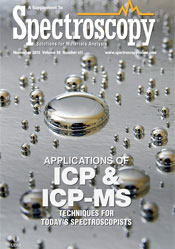In our November issue:
COLUMNS
Molecular Spectroscopy Workbench
SERS: An Update of Progress Made
Fran Adar
The last five years have produced a body of work describing the role of the plasmonic properties of metals in enhancing the signals in surface-enhanced Raman scattering (SERS). We now foresee production of surface-enhancing films and particles that could provide reproducible Raman signals for SERS use in environmental and biomedical studies.
Read more >>
|
| |
 |
| |
Lasers and Optics Interface
Applying LIBS to Metals Processing
Emanuela Grifoni, Stefano Legnaioli, Giulia Lorenzetti, Stefano Pagnotta, and Vincenzo Palleschi
The application of LIBS to two industrial projects illustrates how the composition of metallic alloys can be measured at a distance and on moving conveyor belts—even when the geometry of the objects is varied and surface coatings are present.
Read more >> |
| |
 |
| |
Spectroscopy Spotlight
Revealing the Mechanisms of Diffuse Reflectance IR
Diffuse reflectance is a well-known sampling technique in mid-infrared and near-IR spectroscopy. Despite its significance, however, the underlying mechanism of the technique is not well understood—particularly in mid-IR diffuse reflectance. Eric B. Brauns of the University of Idaho has developed an instrument capable of studying the mechanism, using time-resolved measurements.
Read more >> |
Focus on Quality
What Is Data Integrity Training?
R.D. McDowall
The UK regulatory body issued a guidance that requires the establishment of a data governance system, part of which is data integrity training. Easy to say, but how do you do it?
Read more >> |
| |
ADVERTISEMENT
New ED-XRF White Paper
Mitigating Matrix Effects with Advanced Spectra Handling Functionality
A key advantage of high accuracy ED-XRF analysis is its ability to measure samples directly, with minimal preparation enabling rapid screening. For accuracy, this requires eliminating errors called matrix effects. But for consistently high-accuracy results, especially when sample contents are unknown, additional spectra handling functionality is required. This paper explains why this additional functionality is critical to ensure consistently high-accuracy results.
 Learn more Learn more |
PEER-REVIEWED ARTICLE
Lineshapes in IR and Raman Spectroscopy: A Primer
Michael S. Bradley
The shape of the peaks in infrared (IR) and Raman spectroscopy is often not well understood. Bandshapes largely depend on interactions between vibrating molecules and their environment. An understanding of this relationship can enhance spectral interpretation and can explain unexpected behaviors.
Read more >>
|
| |
ADVERTISEMENT
New Application Brief
At-Line Micronutrient Analysis Using ED-XRF Spectroscopy
The ability to conduct elemental analyses of materials at the production line is improving product quality and consistency while maximizing throughput. This is especially true in micronutrient analysis where traditional lab-based QC methods add costs and delays to processes already operating with thin margins. This paper explains how a new generation of portable lab-quality spectrometers designed to operate in a production environment is changing work processes.
 Learn more Learn more |
| |
|
 |
Download the
issues: |
 |
 |
 |
 |
 |
 |
| |
 |
| LIVE WEBCASTS |
The Power of Stable Isotope Ratio Analysis for a Better Understanding of CO2 in Our Environment
Tuesday, November 10, 2015 at 11:00 AM EST
Register Here >> |
ICP-OES or Flame AAS – Which Spectroscopic Method is Best for You?
Thursday, November 19, 2015 at 11:00 AM EST
Register Here >> |
|
If you would like to submit an article to Spectroscopy, contact Laura Bush, Editorial Director - lbush@advanstar.com
Spectroscopy is free to qualified subscribers. To subscribe, click here.
Click here to contact the Spectroscopy sales team. |



